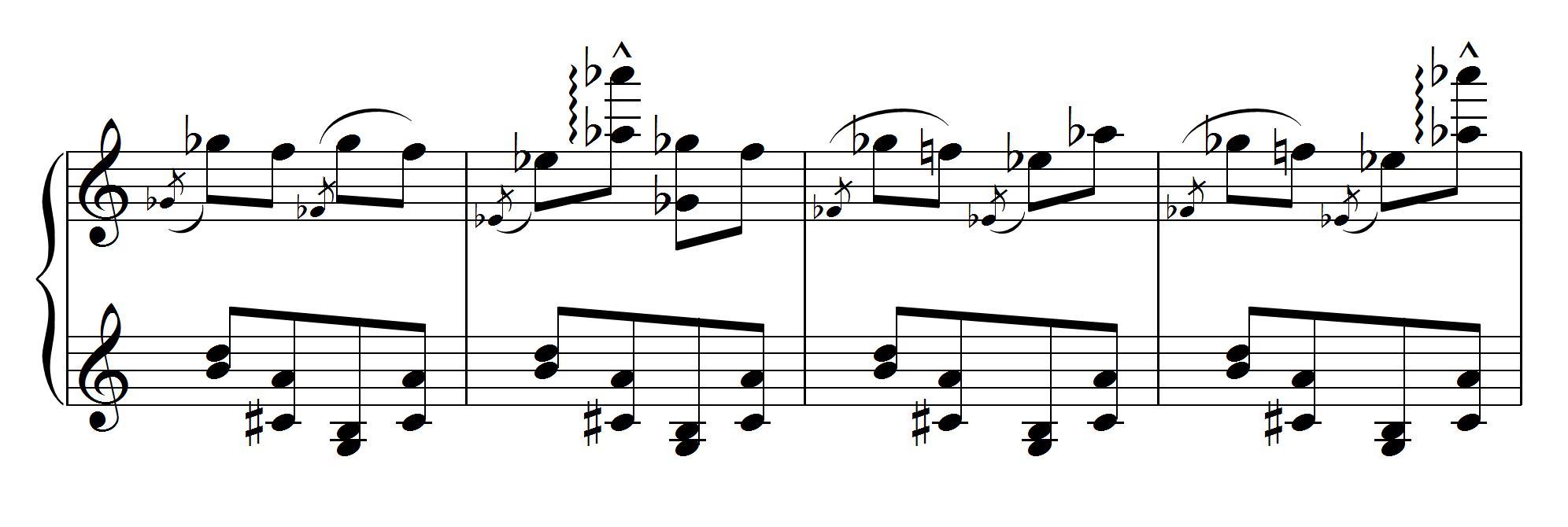“The LH grace notes/mordant is super awkward as written, but falls nicely between the hands if one takes the first note in the left-hand thumb and the next in the right-hand thumb.”
Submitted by James Palmer
Published on 8/27/2021

“The LH grace notes/mordant is super awkward as written, but falls nicely between the hands if one takes the first note in the left-hand thumb and the next in the right-hand thumb.”
Submitted by James Palmer
Published on 8/27/2021

“This redistribution helps the right hand avoid changing positions or crossing over with 2.”
Submitted by Michael Clark
Published on 1/27/2020
Original:

Suggested performance:

“The F-flat grace notes in mm. 105–6 are extremely awkward when played in the right hand. Catching them with left-hand 5 eliminates the crowding.”
Submitted by Michael Clark
Published on 2/13/2022


“Taking the B-flat from the lower staff into the right hand in m. 158 is the only way I can manage the awkwardness of this measure. When possible, taking the grace notes in the left hand facilitates a stronger sforzando on the arrival note.”
Submitted by Michael Clark
Published on 1/1/2020
Original:

Suggested performance:

“The B-flat grace note in m. 220 is extremely awkward when played in the right hand. Catching it with finger 5 in the left hand eliminates the crowding.”
Submitted by Michael Clark
Published on 1/1/2020


“Though no hand configuration makes this passage easy, I find it easier to take the bottom voice of the top staff in the left hand to facilitate the incredibly fast right-hand sixteenth notes.”
Submitted by Michael Clark
Published on 1/1/2020

“Taking these two notes in the right hand eliminates this awkward fingering challenge.”
Submitted by Michael Clark with thanks to Robert Roux
Published on 1/1/2020

“It’s hard to find a comfortable fingering for the right hand alone due to the layout of black and white keys in this scalar passage. Taking these four notes in the left hand eliminates the problem.”
Submitted by Michael Clark with thanks to Robert Roux
Published on 1/1/2020

“I find that taking the F-double sharp in the right hand is more reliable. My left hand can make the leap to D-sharp more accurately without worrying about getting to a white key after.”
Submitted by Michael Clark with thanks to Robert Roux
Published on 1/1/2020

Submitted by John Kline with thanks to Vladimir Ashkenazy
Published on 2/29/2020

“I use this fingering because it allows the right hand to stay in a relatively close position. Playing the right-hand thumb on the first note of each fragment, which is an undershape up to the fifth finger, causes the elbow to have to move further and more precipitously from left to right than the 1 2 5 undershape. The overshape from the top note down to the thumb doesn’t cause the arm to move as much. This is very important in the very quick tempo of this piece. In addition, it is closer to move the thumb from the last thumb up to the top note. And lastly, taking the first note of the fragment with the left hand allows the right hand one extra note to complete the movement up to the top note.”
Submitted by Deborah Cleaver
Published on 1/2/2022

“I’ve always found this right-hand run difficult to play accurately. Taking these two notes with the left hand (while the lower notes are sustained with the pedal) helps me negotiate the position shifts more easily.”
Submitted by Michael Clark
Published on 7/30/2021

“Letting the left hand thumb start the final group of triplets allows a more comfortable fingering for the remainder of the passage.”
Submitted by Michael Clark
Published on 7/30/2021

Submitted by Jake Holtzman
Published on 12/31/2021

Submitted by Melinda Smashey Jones
Published on 12/29/2020

“The right hand can assist with this awkward left-hand pattern.”
Submitted by Michael Clark
Published on 8/11/2021
Fingerings in Italics are Liszt’s.

“Finding a suitable fingering for playing the C-double-sharp in the right hand is difficult. Taking it in the left hand solves the problem.”
Submitted by Michael Clark
Published on 1/1/2020

“Splitting the octaves between the hands improves legato. Some of the sixteenth-note figures are very awkward, so taking the occasional note in the left hand helps. Grabbing the last three notes before the right-hand leaps facilitates a secure shift.”
Submitted by Michael Clark
Published on 1/1/2020